Text
FRIEDBERG, The Lexington, London, 5/3/25
To the Lexington on a sunny Wednesday evening to see the band described by the Guardian as “cooler than a Brooklyn basement in winter”, Friedberg. Hand ink stamped, and up the stairs, I remembered why this is such a great venue, and regretted letting it slip off my radar for so long.
Shallow, wide and with a low stage, this is musical intimacy at its best. Support act, South London’s Rats-Tails, are clearly building a following, with an enthusiastic group at the front letting loose to their dream rock, with its echoes of Last Dinner Party.

After a quick trip downstairs for refreshment, we were right in front of the stage watching the set up for the main event. So close we could read guitarist Emily Linden’s copy of the set list, annotated with key changes, tunings and “talk” . You know you’re in for a good time when two sets of cowbells appear. And from the opening riffs of their current single “My Best Friend” that promise came through.
Friedberg are led by Austrian singer-songwriter Anna F, with Linden on guitar (and some of those cowbells), Cheryl Pinero on bass and Fifi Dewey on drums. Experienced musicians, they commanded the compact space with energy, discipline and downright good times as they served us heavy helpings of dance-rock , with notes of Warpaint and LCD Soundsystem. (Excellent reference points in this reviewers’ book!).

The dancefloor got started, and didn’t stop through a tight set that worked through tracks from their latest release, “Hardcore Workout Queen”. Particular highlights were the harmonies of “Venice 142”, the pumping rhythms of the album’s title track, and a cover of “Eisbar” (Polar Bear) which turns out to be a rather great early 80s track by Grauzone . But there didn’t feel like a duff note all evening. The band’s energy and enthusiasm was infectious, as they grooved together, extolled the virtues of their T-shirts, and gave birthday shoutouts.

The last chords of “The Greatest” fading as they left the stage, and a chorus of “one more song” immediately broke out, This was rewarded with a triple encore of “Go Wild”, “Hello” and “Midi8” - a treat I’d have seen coming if I’d read Emily’s set list. Friedberg roused the crowd one final time, and left us all buzzing, grateful that a band like this are still playing venues this size.
Words: Charlotte Beckett; Photos: Richard Gray
Full photo gallery
0 notes
Text
Great Lake Swimmers, “In Pieces” tour, Rich Mix London, 17/10/24
Logistical juggling meant we walked into Rich Mix just as Paper Beat Scissors – not to be confused with the similarly named hip hop trio – was wrapping up his slow-folk acoustic set. The standard gamble that the support act is worth spending time in the bar for didn’t pay off this time. The last notes of his gentle voice and guitar was the perfect set up for the evening (and have since been on Spotify repeat).
Just time to find our spot amongst the assembled Gen Xers before Great Lake Swimmers joined us for an acoustic retrospective of over two decades of work – promoting the release of “In Pieces” earlier this year. The band is currently a touring as a trio, with founder Tony Dekker (guitar, harmonica) joined on stage by Ryan Granville-Martin on drums, and Colleen Brown on keys, guitar and bass. Brown, an established artist in her own right, also provided perfectly balance to the other two’s vocals. (Insert your own comment about women doing double the work here).

Kicking off with “Still”, swiftly followed by “Moving Pictures Silent Films”, the set promised songs from every album, including rarely performed tracks (“except for last night, quipped Granville-Martin) such as “Three Days At Sea”. Whilst perhaps these were less successful, this was indie-folk Americana at its warm best: exceptional musicianship and glorious harmonies filling the space (Dekker’s voice leaning close to Neil Young at times).

Between songs both Dekker and Granville-Martin took full advantage of Rich Mixes’ intimacy to make this feel like an evening with friends with tales of the rock and roll of touring (getting phone screens repaired in Brick Lane) and song origin stories. They were clearly enjoying themselves. The common themes of new beginnings, rear view reflections and meditations on time were, in fact, published in a lyric book available on the merch stall. As Dekker pointed out, given that the internet believes his paean to love to be called “Rocky Spleen” this is probably a worthwhile investment. (This expansion of the musician universe seems to be on trend, with John Grant promoting his version from the stage the previous week).
“Changing Colours” gets the first “woops” of the evening, with fans turning to their tag-alongs to exclaim you must know this. Then “Where In The World” gets the first gentle swaying and (mostly in sync) knee bending before Dekker whips up a full foot stomp on the concrete floor for “Rocky Spine”. Mixing the classics with deeper cuts, this is a back catalogue that lends itself perfectly to the paired back acoustic set and the intimacy (and welcoming service) of a venue like Rich Mix. This is music to sit down and think to. And that’s a complement. For this reviewer at least this was a welcome reminder of just how great Great Lake Swimmers are.

Words: Charlotte Beckett; Pictures: Richard Gray
Full photo gallery
0 notes
Text
REAL ESTATE, Hackney Church, London 3/10/24
An autumnal evening sees us picking our way through the gravestones to the elegant entrance of St-John-at-Hackney. Once inside, we’re greeted with the immaculate minimalism of the recent (ish) refurb and the long echoes of church’s centuries old “day job”, and by a growing crowd of music fans of all ages. Architectural and audience vibes set, we’re ready for tonight’s event.

First up, Far Caspian, moniker of Irish singer-songwriter and producer Joel Johnston. Despite at times having to battle with feedback, the six piece kept heads nodding with their understated, almost nonchalant, indie rock. A short break (shout out to the glowing hi-vis guitar techs – a strong look more should adopt) and Real Estate get right down to it with the dreamy strum of “Something New,” the breezy opener from 2024’s “Daniel”, then into “Say No More” from the same album. Both are the perfect vehicle for Real Estate’s greatest strengths, particularly Martin Courtney’s warm, intimate vocals and the weaving, hazy harmonies of Courtney and Julian Lynch’s guitars.
In all, seven tracks from “Daniel” made the cut, including the comfortably familiar “Flowers” and Sammi Niss’ crisp breakbeats of “Freeze Brain”. However, tonight isn’t just about promoting a new release. The set list is perfectly crafted to take us nostalgically through the different eras of their discography. Over the span of close to 90 minutes, Real Estate weaved across their repertoire. From the likes of 2009’s “Suburban Dogs” to 2020’s “Paper Cup”, tracks from every album made an appearance. But it was the bangers “It’s Real”, “Darling” and the latest earworm “Water Underground” that rightly got people on their dancing feet, singing along.

The band’s easy presence is the mark of true experience, of seasoned performers who have spent enough time onstage it feels normal and natural, like home. This isn’t a band about theatrics and bombast, rather one that lets the music do the talking. The crowd were entranced from the get-go, and the sea of recording phones was notable by its absence tonight. As Courtney says early on, it’s all starting to feel a bit spiritual.
Real Estate were as charming as we’d imagined them to be, and their sunny melodies carried us back out into the cooling night. To paraphrase the mighty Pitchfork, the Real Estate effect is like having drinks with your neighbour. It may not be your wildest adventure; “you say goodnight … by the time you get home you’ve forgotten what you talked about, but that doesn’t mean it wasn’t a good hang.”
Real Estate are: Martin Courtney vocals, guitar; Alex Bleeker, bass; Julian Lynch, guitar; Matt Kallman, Keyboards; Sammi Niss, drums. You can find the full set list here and our full photo gallery here.
Words: Charlotte Beckett; Photos: Richard Gray

0 notes
Text
Bat For Lashes, Barbican, London 24/06/24
A certain magic on sprite night
Bat For Lashes, aka Natasha Khan, has one of the best voices in popular music, an expansive ocean swell that lifts and suspends the listener in Barbican’s Grand Hall. Perhaps because of the prestigious venue, a plinth in the cultural stratosphere, she opts for a greatest hits show rather than a deep dive into her recent release The Dream Of Delphi. And it’s a clear success.

Close Encounters, from 2016’s The Bride, is haunting and operatic. She shakes it up with an R&B version of Daniel. Her collaboration with Beck for the third Twilight film, Let’s Get Lost is there.
The Hunger is wistful, dreamily, lazily downstream and the beautiful, plodding melody, The Wizard is Jane cliche. The bewitching, mischievous Sarah has echoes of Nick Cave in structure and tone. Letter To My Daughter is inspired by a Maya Angelou poem of the same name and a subsequent poem If You Be The Universe is a tender, acid like wonder in itself.
Khan forgets the first line of piano ballad Moon and Moon, wryly blaming ‘sprites in her memory’.
Laura Groves on keyboard and Charlotte Hatherly on guitar keep it tight throughout.
On the final encore Laura, a paen to her best friend, she sings ‘You’re more than a superstar.’ Bat For Lashes is not a superstar by the usual markers, but she strides Barbican’s stage in an elfin’s white dress with verve. And that voice, oh that voice.

Words: Adrian Cross; Photos: Richard Gray
0 notes
Text
Love with Johnny Echols and the Stockholm Strings ’n' Horns Ensemble
O2 Shepherds Bush Empire, London, 20/07/24
Go Johnny! Seventy and Seven Is
There are few surprises when a classic album is played in its entirety but this is an enthralling set as the only remaining member of Love, its founder and lead guitarist Johnny Echols, teams up with the Stockholm Strings ’n’ Horn Ensemble to run through the immortal Forever Changes, fully replicating the classical and Spanish inflections underpinning its surreal folk psychedelia.

The version of Old Man is richly layered and The Red Telephone is as haunting as ever. Live and Let Live is as thrilling as in the studio, although its climatic guitar break is somewhat fluffed on the night.
Rusty Squeezebox (aka David Ramsay) is a rousing frontman and the new band’s nucleus returns for a second set of pure rock ’n’ roll with the ornamental backing taken out; featuring outtakes from Forever Changes and tracks from first album, Love, and final recording, Da Capo. Echols, now seventy seven, started playing with Little Richard at thirteen and he gets full licence to show his plectrum wizardry and his vocal abilities on Orange Skies. The only blemish is that She Comes In Colours is surprisingly absent. The group bring the evening to a fitting crescendo with Da Capo’s thumping Seven And Seven Is and the O2 Empire howls its approval.

Words: Adrian Cross; Photos: Richard Gray
0 notes
Text
Bill Nace, Cafe Oto, London 23/05/24
The birth of a compelling sonic monster
Philadelphia’s Bill Nace is a one man Swans. Just like New York’s high decibel post punk outfit he is bludgeoning the listener into transcendence here on the first set of his three day Oto residency. He sits with an array of foot pedals like chemistry vials in front of him and ‘a modified Frankenstein thing’ on his lap that he’s fashioned at home: that is to say, a rectangular wooden box with strings and church organ or typewriter keys. The ‘thing’ has a boutique craft appearance, but whips ear splitting sound into the speaker next to him: atonal patternings reminiscent of mimimalists Reich and Glass, but violently so, to a backdrop of searing, distorted noise.

At times it’s like a pagan dance, but these revellers have blades on their feet and are lacerating the earth beneath them as they cavort. Further proof, if it were needed, that anything can induce a religious experience if the alchemy is right. Borne up, shaken, tossed out and left ringing like tuning forks, the Oto faithful roars its approval for the experimental guitarist and visual artist whose collaborative namechecks include Yoko Ono and Thurston Moore.

Words: Adrian Cross; Photos: Richard Gray
0 notes
Text
Elaine Mitchener, Cafe Oto, London 08/05/24
Elaine Mitchener walks on at Cafe Oto wearing a T-shirt with the statement ‘Grace Jones does it better’. This may be true, but Mitchener does it extraordinarily. The glacial, demur Grace Jones would find her exhausting, multi-layered vocal performance fascinating. Technically she can turn her vocal chords to any style with equal panache: soul, opera, jazz, far Eastern tones. Combined with an incredible range of vocal tics and physical contortions she moves seamlessly between melody and discord. She has been awarded an MBE for services to music.

The poems of Afro Caribbean poets, such as Edward Kamau Braithwaite, are channelled on her latest album Solo Throat. She is presented with pieces of paper by some of the other musicians who have performed that night, the contents of which are not explained. They could be lines of poetry to improvise messages or only a visual gimmick, a kind of visual punctuation, metronomy, beat.
The evening began with a striking prose poem on the Windrush arrival from Jay Bernard, his delicate, haunting whistles sampled and harmonised and gradually expanded with the addition of keyboard, bass, flute, piccolo and sax. ‘Someone whistled in 1948, but I’m hearing it now.'

A less interesting piece of poetry from Roy Claire Potter put to sound over the drums of Mark Sanders and violin of Mandihra de Salam followed before Michener appeared with dancer Dam Van Huynh to deliver a startlingly contorted and intense movement performance to a backdrop of piano from Pat Thomas.
The evening culminated in Mitchener bringing together all the night’s musicians and all of them wheeling into free jazz reaching a crescendo from Mitchener that shook Oto’s golden ceiling filaments and had its audience screaming in delight. Powerful, indelible, of an ilk no stranger to Oto regulars, but utterly mesmerising and original and even disturbing for any crossing its threshold for the first time.

Words: Adrian Cross; Photos: Dawid Laskowski
0 notes
Text
Jane Weaver, Scala, London 02/05/24
Widnes siren a delight and constant spectacle at the capital’s Thunderdome
On The Revolution of Super Visions Jane Weaver sings ‘Overgrown with something. Do you look at yourself and find nothing?’ As if tapping into the mystery of why she has not reached the firmament.
The legendary Scala, which channels Mad Max’s Thunderdome as people drip over its balconies gazing upon the stage, has bitter memories for Weaver, which she hopes this evening will dispel. When she last appeared in 2022, supporting Richard Hawley, Mercury announced it was pulling her record deal during the sound check. This was another slice of poor luck with the music megacorps that has at times dogged her career. On the verge of being signed by Factory Records in 2015 founder Rob Gretton died of a heart attack before her album could be released.

Once supported by North West heavyweights Doves and Elbow and highly regarded in music circles, her sophisticated, but accessible and ethereal trippy psychedelia, bearing the influence of Gong, has inexplicably, barely penetrated mainstream consciousness and it’s less talented, bloated fish who have sucked up the available oxygen.
Only occasionally has she popped the membrane of relative public obscurity. The rejuvenative, but dark undertones of single, Modern Kosmology, were the perfect backdrop to Villanelle eating pizza in Killing Eve. Weaver did reach no.24 in the singles chart in lockdown, but intimates she’s been placed higher in the celebrity foot appreciation site Wikifeet!

Perhaps in the marketing sense she has never aggressively pushed herself and selflessly promotes other acts on her own Bird label. Undemonstrative on set, as are the band, the songs are delivered with a restraint that could transform the venue into an all encompassing, theoretical mass of swirling sound, but it isn’t. Notwithstanding the Scalalites are largely middle aged, more preoccupied, no doubt, with bladder relief than MDMA, it’s only at the encore that they throw shapes for the spine tingling, soaringly propulsive I Need A Connection.
That said, we’re treated to the very best on her latest acclaimed release on Fire Records, Love A Constant Spectacle; from its soaring title track to the virtual prog rock of Perfect Storm, the 80s post new wave of Is Metal and the pagan, English folk inflections of Family Of The Sun. Plus shrewdly selected highlights from her back catalogue of almost a dozen albums.
Each melody is irresistibly infused with ambient, space age tweaks and overlays in the spirit of SunRa and jazz fusion. Weaver’s voice is as technically accomplished and transformative live as it is in recording. Even at fifty two, she sounds thirty years younger. Discarnate, supernal. We experience the rapture, her cosmic sunshine midst the melancholia.

All that is missing is Kosmology’s ecstatic I Wish. Mission Desire, from 2014’s breakthrough album, The Silver Globe, seems to further accelerate us on this galactic journey. Your mission, dear reader, should you choose to accept it, is to dig Jane Weaver.
Words: Adrian Cross; Photos: Richard Gray
0 notes
Text
Police Dog Hogan, Bush Hall, London 26/04/24
Chandeliers dimmed for a Hogan hoedown
London’s Police Dog Hogan could be any regular band playing at the back of a bar in the southern states of America. Visually they’re seven snake oil peddlers of the Wild West. The trilbys, waistcoats, western shirts, banjo, fiddle are all in place. The stage’s crimson, vaudeville backcloth only binds the illusion. There is the air of a good time wedding band about them. But what does distinguish the group is a skill for inveigling scenes of workaday British life into country, bluegrass and Irish folk imitations. To borrow from Amy Winehouse, they’re a ‘safe bet’ and five albums in, trail a loyal, middle aged fan base filling Bush Hall’s grand, yet intimate, Edwardian interior.
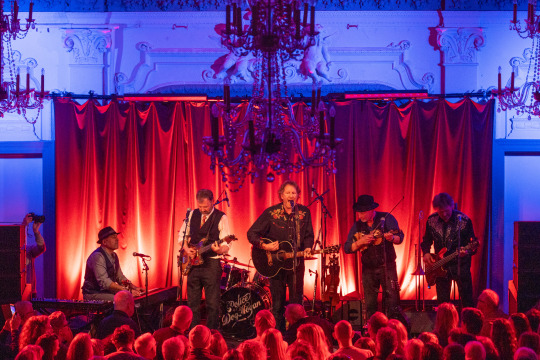
They begin with Dylanesque stomps, one of which has more than a passing nod to Blood On The Track’s Lily, Rosemary and the Jack of Hearts. Then there’s a change in tone with the melodic, melancholic, Beatles-like ditty, Funfair On Shepherds Bush Green, which prompts the night’s first witticism from vocalist, James Studholme; as he pokes fun at the VIPs listening behind ‘soundproof glass’.
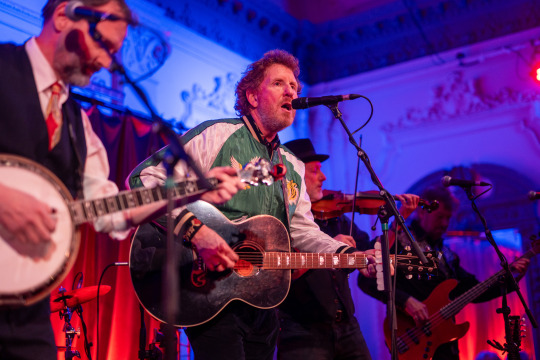
He’s on a roll now aiming an affectionate dig at sidekick Tim Dowling limbering up. What he really missed during Covid wasn’t the ‘sound of a motorway or the sight of vapour trails, but banjo tuning’. Dowling, The Guardian columnist-cum-banjo player asked AI to create the first new joke for the instrument in eighty years and served us the result. Spoiler alert, it takes four banjo players to change a light bulb.There isn’t even any logic on display from the chatbot with that one. The band are currently penning a song every three weeks and the new material is strong.
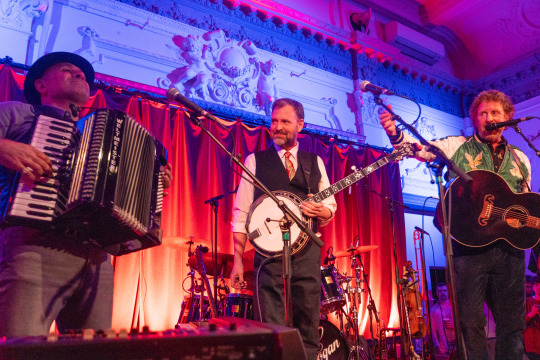
The latter part of the set moves away from standard folk and bluegrass to incorporate East European folk tradition in the rollicking Old Mary, and some burlesque and standard rock. It’s refreshed by the addition of a jaunty brass section. Raising the roof are staple crowd pleasers Shitty White Wine, short haul canticle, Barcelona, and the Cornwall surfing special, Crackington. Unremarkable they may be, but PDH are decent craic, to be sure.
Full photo gallery here.
Words: Adrian Cross; Photos: Richard Gray
0 notes
Text
Keiji Haino and Apartment House at St John's Church, Bethnal Green, 14/3/24
A sign over the door as you enter St John’s of Bethnal Green says the church was burnt down in the middle of the nineteenth century, but was then re-built. It’s now falling down in the twenty-first century and is trying to raise money to re-build itself again, partly by playing host to Keiji Haino, amongst other artists, in a world where the rituals and artefacts of traditional christianity now seem as outlandish as some of the artists now making use of its space. There’s paint peeling off the walls but a set of strikingly modern stations of the cross give a hint that this church is very much of the here and now.
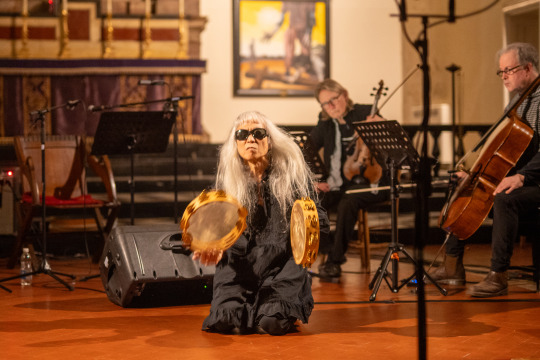
Some of the Shoreditch faithful filing in and taking their pews (still fixed to the ground unlike many other churches looking similarly to exploit commercial or community opportunities - Archers fans, you’ll know what I’m talking about) notice, ahead of an 8:30pm start that they were warned would be sharp, that Keiji Haino - at least we assume it is he, in trademark bugged dark glasses and flowing grey locks - is blowing a hairdryer on his tambourines near the altar. Looking on nonchalantly are a quartet of classical musicians, The Apartment House, as if to say “Yeah, he does that”. This is the last night of a three-day residency by Haino organised by Cafe OTO.
On the dot, Haino, a sort of modern-day Stoic who eschews all drugs, meat and alcohol and, I’m informed by a sort of Haino devotee sitting behind me, has been known to abandon a show if he sees someone drinking in the audience (I hope he doesn’t spot one of the many craft beer bottles perched on the pews), springs into action, grabbing his warmed-up tambourines and prostrating himself on the floor (not quite on the altar, but not far from it). The scrapes and the clatter of the instruments fill the silence of the old building - it has excellent acoustics. Haino gets down on his haunches then jumps into the air, his silver locks flailing around him. He brings forth a range of noises to which the word “tambourine” doesn’t do justice (They are more correctly perhaps tambourins?). After about ten minutes, the quartet joins Haino with surprisingly conventional baroque-sounding accompaniment.
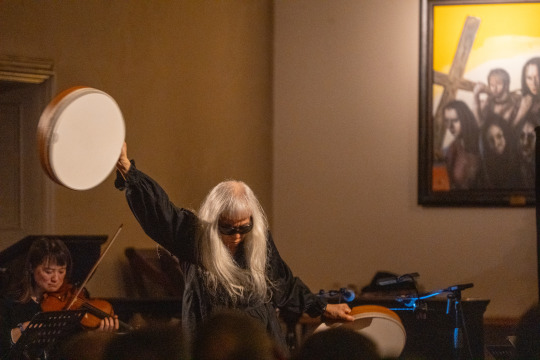
Other pieces descend into discordant and abstract noise with Haino, now sat on a sort of wooden throne, shrieking and moaning animalistically, but these are interspersed with covers of Summertime and Strange Fruit. Neither are what you would call straight, but you can hum along.
None of the pieces performed end on a note or a chord that signals to the audience that they can now start clapping and every time there is an awkward silence. Each time, someone (presumably one of the organisers, or it might even have been one of the quartet) begins clapping and the rest of the audience follows suit. Occasionally a member of the audience starts clapping but no-one joins in and they shrug and give up, embarrassed. Wikipedia says there’s a Japanese concept of “Ma”, or silences in music, which perhaps some of the audience are aware of, but I think it’s more a sort of timid reverence for this art-rock high priest that might, two centuries ago, have been shown to a visiting bishop.
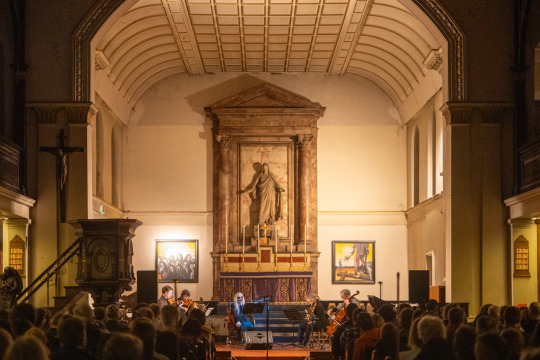
Words and photos: Richard Gray
0 notes
Text
Cassie Kinoshi, seed. plus NikNak. Barbican, London 8/3/24
On the eve of International Women’s Day Cassie Kinoshi performs her biggest headline show to date, to debut a project Offerings, commissioned by Serious and highlighting the forgotten role of women in jazz during World War Two when the male bandleaders went off to fight. She is unequivocal about them being overlooked. “Britain is racist,”she says.
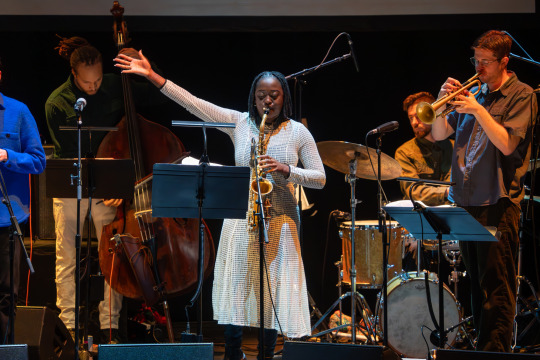
She celebrates the emergence of all female bands on the circuit at this time such as Hilda Ward’s Lady Syncopators and Evelyn Hardy & Her Ladies Band.
Before this we are treated to pieces from new album "gratitude", to be released on the 22nd of this month and first premiered live in 2023. Her erstwhiles, 10 piece seed., featuring Ezra Collective keyboardist Joe Arman-Jones, are teamed up with the London Contemporary Orchestra and DJ NikNak to produce a sound rich in orchestration, Blue Note and African rhythms.
Inspired by her mother’s gratitude book, where one thing to be thankful about each day was recorded, but at a deeper level about mental health and community, three of its four movements are performed here, each contrasting in mood and giving prominence to a different instrument. It is also designed to be a reminder of the perennial struggles of gender, race and class and Kinoshi also rails against institutions preventing artists speaking out on political issues.
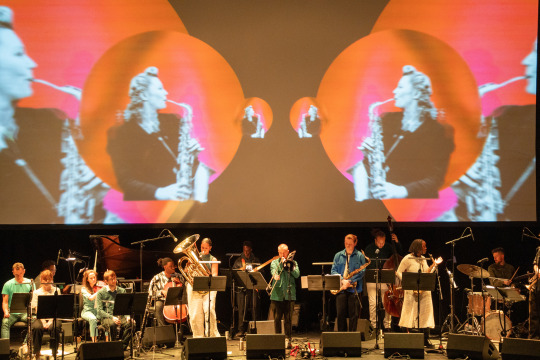
The movements are performed to a visual backdrop from GURIBOSH featuring tides, echoes perhaps of seed.’s 2019 Mercury nominated Driftglass. Since then Kinoshi has produced music for theatre productions at the National Theatre and The Globe as well as the London Symphony orchestra.
There are sounds of nature and celestial aural tweaks like the heyday of jazz fusion and optimistic, uplifting poetry from Belinda Zhawi.
Each of Offerings has the original voice or music of the resurrected musician as an intro or coda and the three pieces culminate in a wild frenzy of tuba playing, not unlike the work of Charles Mingus.
Musically there is little that is new in this work, but it is beautifully conceived. It’s Kinoshi’s ability to synthesize different genres that marks her out and seamlessly blend in extra dimensions like spoken voice. Barbican’s audience takes a while to warm, but this is from inhibiting respect for decorum not inclination and, by the end, the ensemble is ecstatically received. The only disappointment is the length of the show, just over one hour.
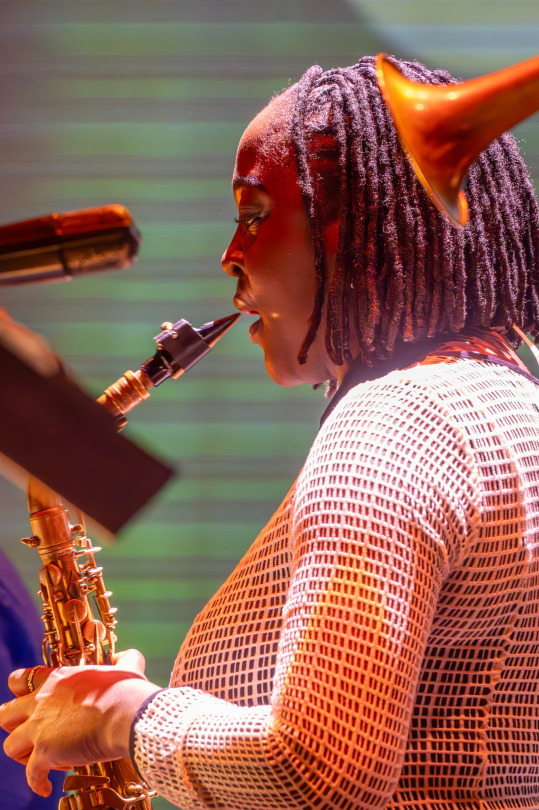
Words: Adrian Cross; Pictures: Richard Gray
A full gallery of pictures can be viewed up to three months after the gig here.
1 note
·
View note
Text
Xylouris White
Cafe Oto, London, 20/12/23
You know there are going to be earthquakes at a Xylouris White gig, that their mystically hypnotic power might open up fissures in the floor. Jim White can boom the bass drum with the earth flattening intensity of John Bonham. It inches it’s way towards the seated section of audience at Cafe Oto, as if stealthily fleeing the battering it’s receiving from White; like the technique in horror movies where the spectre appears much closer than is humanly possible with each frame.

In the intimate salon that is Oto you sometimes wince and start, as if at a public flogging. However White is a vaudeville flogger, a unique and compelling percussionist. His left arm ascends and curls like a magical CGI creature materialising into the air and comes flying down at the snare. His right drumstick sluices across the cymbals, another tick in his wizardry. He stares out at the audience, not with haughteur, contempt or a craving for appreciation, but serene single-mindedness, his features reminiscent of Donald Sutherland.
He would be able to maintain gravitas even if he was dressed as a wrestler. It’s easy to fixate on White’s flamboyant presence, but his partner, Giorgos Xylouris, sometimes becoming red in the face, as if struggling to keep pace with the Australian drummer, is a highly skilled vocalist and laouto player in his own right: the laouto being a Cretan lute. It’s usually an accompanying instrument, but deployed by Xylouris in a solo capacity. His lyrics are rooted in nature and the traditional rhythms of Mediterranean life.

This is rock mingled with folk in beguiling, thrilling combinations. It bears the imprint of White’s work in The Dirty Three with Mick Turner and Warren Ellis of Nick Cave’s Bad Seeds. He has also collaborated with PJ Harvey, Cat Power, Marianne Faithful, Bill Callahan and Beth Orton amongst others.
The pair first met in Melbourne in 1990 when Xylouris was touring with his father and have since produced five studio albums. They have a recognisable groove, but are constantly re-inventing and adding adornments to their music.
The first of two sets opens with Second Sister, an instrumental from April’s Drag City release The Forest In Me. It has a flamenco flavour. Telephone Song from 2019’s album The Sisypheans, also has the raw intensity of flamenco’s cante jondo. ‘Soar on a single wing and should you conquer time…’ Giorgos sings.
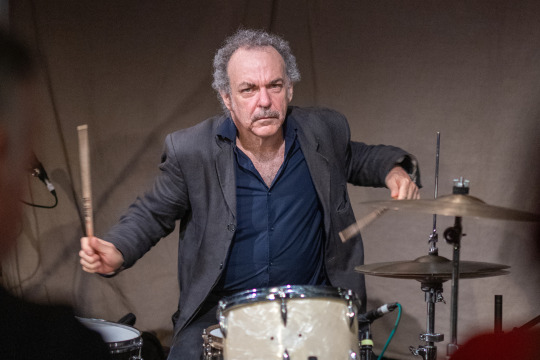
Black Peak from the 2016 Bella Union album of the same name has a breakbeat reminiscent of electronica, similar to that deployed by Manchester jazz trio Go Go Penguin, and a delirious riddle of a laouto line. Hey Musicians! is a foreboding, hymnal call to arms. Xylouris whistles through its latter bars. The Feast is a composition about killing a hundred animals. “Everyone’s probably vegan in here!” quips White. It starts slowly before the pounding hooves of White’s drums are on the stampede again.
The Forest in Me is largely a set of minatures coming in at two minutes or less. Night Club has delicate, haunting rhythms and Xylouris on a single stringed instrument. It’s accompanied by a humorous ancedote from White about his brother leaving a scarf at Taylor Swift’s house, which she didn’t return. Latin White is dedicated to film maker Rebecca Marshall, a recent collaborator on videos with the duo. It’s reminiscent of a folk dance and White takes up guitar for it. “Not that hard after all,’ he says wryly. Red Wine, another instrumental from The Forest In Me, flows like the fly past of a flock of geese.
On The Sisypheans’ Forging Xylouris sings of the earth trembling underfoot and ‘the wrath of the world forever increasing’. Though not in this evening’s sets it’s a neat summation of the extraordinary timbre and transcendance in the duo’s music, leaving the Oto crowd appreciatively buzzing to its core.
See see our full photo gallery click here.

Words: Adrian Cross; Photos: Richard Gray
0 notes
Text
Michele Stodart
St. Pancras Old Church, London, 30/11/23
Michele Stodart has a CV in the rock world second to none. Bassist and vocalist in the The Magic Numbers, festival curator and promoter, actress in Danny Boyle and Richard Curtis’ Yesterday and musical director at the UK Americana Awards.
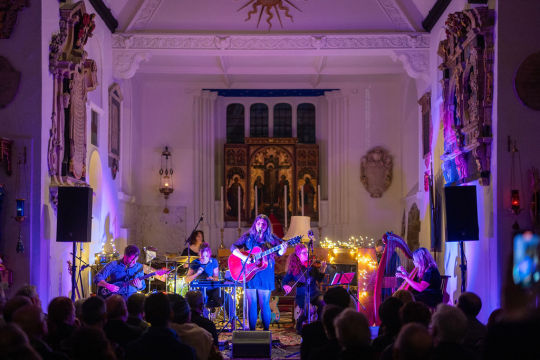
But there’s nothing aloof about her. Here she is baring her soul at the intimate St Pancras Old Church ‘inviting in the darkness’ as she says, by way of explaining the title of Invitation, her third and first album in seven years. The theory being that it is in the ‘listening and learning that we can transform’. It’s fitting that Stodart extirpates some of her demons in a church named after the Roman Christian martyr, whose name in Greek means the one that holds everything.
She says it’s important to surround yourself with people who ’lift you up’, the implication being this principle guided the composition of her backing band, which features singer songwriter David Ford on guitar, Andy Bruce on piano, Holly Carter on pedal steel and Emma Holbrook on drums
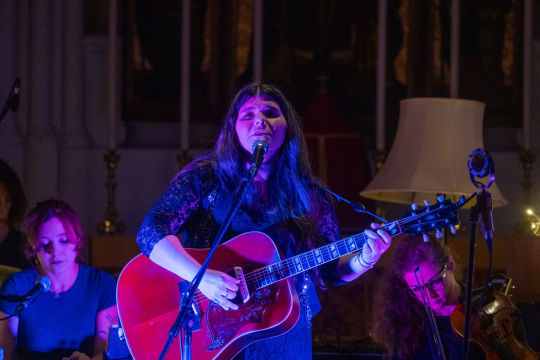
The first set is a run through of the album that culminates in Drowning, expiating quietly, like a last breath at its end. There are the tranquil, comtemplative, healing melodies of Undone and Come Dance With Me and the strolling blues of These Bones. The highlight, as it is on vinyl, is the desperately poignant Tell Me.
The songs, whether acoustic, piano or violin-led do indeed feel transformational and often slow burn to a crescendo. After the interval Stodart introduces new compositions including collaborations with Ford and special guest and singer-songwriter Kathryn Williams, who quips “I was enjoying this amazing gig now you’ve spolied it!” for a song called Lucky Ones. Brother Romeo, lead singer of the Numbers, is in the audience, and whoops flit appreciatively around the chapel like swallows on a serene, intermittently playful, night.
The full photo gallery, where you can buy prints, can be seen here.
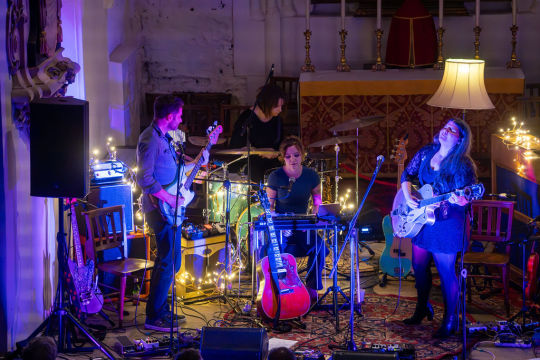
Words: Adrian Cross; Photos: Richard Gray
1 note
·
View note
Text
Joanna Sternberg
St. Matthias Church, Stoke Newington Pitchfork Music Festival, 10/11/2023
Joanna Sternberg prefers to make music alone, tour alone and gets through a performance by not looking at the audience. One of their songs charts the perils of lugging all their instruments around the New York subway. Yet they connect deeply with their audience through a lack of pretension, striking, often hymnal melodies and spades of charm. Songs are frequently paused for amusing asides and sometimes re-started.

Sternberg belongs to a genre, sometimes unhelpfully coined as outsider music. They are very much in the tradition of Daniel Johnston, another whose music brims with complete authenticity. Like him Sternberg takes us to some dark places in their life, but does it with wit and uplifting, deeply humane tunes. As the cliche goes, seamlessly touching a chord within all of us. In truth, they are really an insider. Sternberg lives in Manhattan Plaza, an inter-generational residence and hangout for artists going back to Tennessee Williams and Richard Burton. Their grandmother was a famous cantor and actor in Yiddish theatre. Sternberg learned classical piano as a child, went to jazz school and can also turn their hand to double bass, gutiar, violin, drums, banjo and mandolin.
This is their first time in London, at an intimate and near full St. Matthias’ Church. The set opens on acoustic guitar with the punchy riffs of the acerbic ‘People are Toys To You’ from this year’s Fat Possums release I’ve Got Me. Sternberg quips about their “moody, depressing little songs” as they segue to the album’s title track, then on to perhaps their most perfectly realised composition, ‘Stockholm Syndrome’. Sternberg switches to piano for a sequence of songs with a gospel feel, beginning with ‘Mountains High’ and including ‘Neighbours’, about living in a high rise building and not knowing whether to say hello to people. There is the Regina Spectoresque ‘Drifting In a Cloud,’ documenting the initial elation and subsequent nightmare of being prescribed Zoloft.
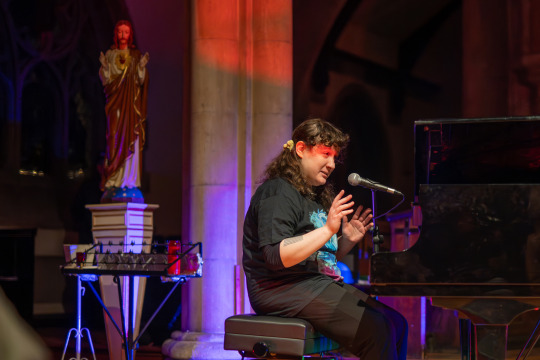
The night ends with the poignant ‘Don’t You Ever’, from 2019’s first album Then I Try Some More, influenced by ragtime. This is about the fraught process of becoming comfortable in the body, not to mention addiction. Then on to a brand new song, ‘The Love I Give’, which Sternberg descibes as a “little passive,aggressive song”, that still feels imbued with a warm, generosity of spirit.
Musically, Joanna is their harshest critic. If not, that would mean “they really hate me!” she cries. As Matt Sweeney, producer on I’ve Got Me, said in Rolling Stone, though they depict intense struggles Sternberg’s songs ultimately feel like victories, fitting in this sense for a church, and delighting an audience whose whoops may echo in the cloisters for some time.
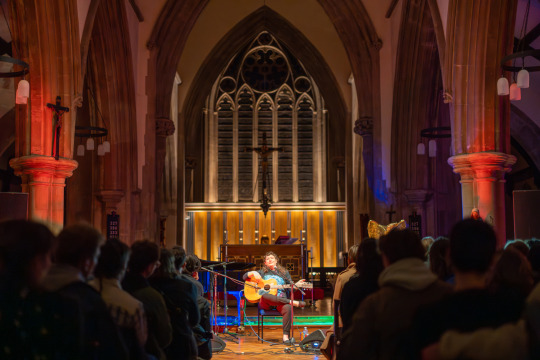
Words: Adrian Cross; Pictures: Richard Gray
See the full photo gallery here.
0 notes
Text
Porridge Radio
Shepherds Bush Empire, 03.11.2022
Porridge Radio pounce on the Empire’s stage to Led Zeppelin’s Immigrant Song and it’s as if they’ve migrated from their true selves for the initial numbers. Even the jauntiest of their New Wave-esque songs have a darker undertow on 2020’s Mercury nominated Every Bad and May’s ingeniously titled Waterslide, Diving Board and Ladder to The Sky (after the subjects of some of lead singer Dana Margolin’s paintings). Yet, oddly, the gig takes on the flavour of a gaily bopping Sixth Form disco as Give/Take, Circling and Jealousy are surprisingly bland, in spite of the Brighton band’s tireless energy and enthusiasm for live performance, exemplified by Georgie Scott bouncing at the keyboard.

It is not until mid-set that it feels we’re back home. Margolin went on record in the New York Times in the Spring to say she loved to sing her thoughts aloud so as to ‘hear them and understand if she agreed with them’. And to repeat those thoughts over and over. Things really lift off with Birthday Party and its fifteen seven times repeated line ‘I don’t want to be loved’. It’s these existential howls that whip the audience into a maelstrom and drag us much closer to the texture of the studio recordings.
The cropped haired Margolin is adept at elliptical statements such as ‘I don’t want the end and I don’t want the beginning’; on the first of a couple of tracks that resemble Nick Cave gothic stompers, the latter being the final song of the night ‘Sweet’. This features the evening’s support acts, Alaskalaska and Memory of Speke, mobbing the stage and indulging in some comic crowd surfing, dressed in judo suits and lab coats and looking, no doubt intentionally, like extras in One Flew Over the Cuckoo’s Nest.
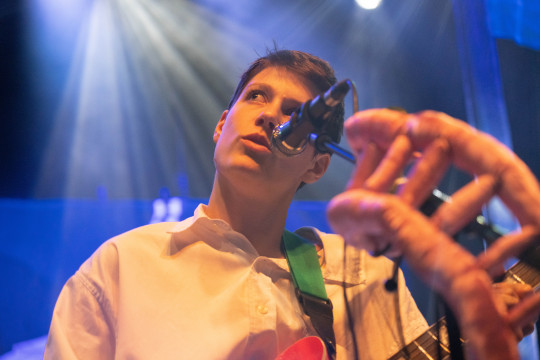
Margolin denies any design to the name Porridge Radio, that it’s a purely random juxtaposition of two unrelated words, albeit both items can be side by side at the breakfast table of course. And Porridge Radio have been accused of being all things to everyone and not settling into a particular genre. This has always seemed unfair as the the group does have a distinctive style and is honed into a recognisably driving groove for the final third.
Even if Margolin does lapse into niceness overkill with the unworkable request of asking those lofty to ensure that someone more vertically challenged behind them can see, the evening ends feeling like good ‘ol rock ‘n’ roll.
Words: Adrian Cross
Photos: Richard Gray
0 notes
Text
Peter Hook and the Light, Joy Division: A Celebration. Brixton Academy, 10.07.2022
Beyond all this good is the euphoria
A greatest hits night at The Brixton Academy, with its ceiling that resembles the lunar surface, is in keeping with the music of Joy Division, but for some fans, will have Ian Curtis turning in his grave, as the band’s bassist continues to tour the back catalogue, following his classical re-boot with Manchester Camarata in 2019.
Even a nuts and bolts celebration of Joy Division seems a contradiction in terms, especially in the height of midsummer, as the performance, after a brief aperitif of New Order, essentially charts the trajectory of a troubled singer’s odyssey to suicide as The Light segues from Warsaw material to the albums Unknown Pleasures and Closer in full.

So little at first glance stacks up in the enterprise’s favour. And there is also the challenge of reproducing live those two albums which are masterpieces of studio production, singularly crafted in 1979 and 1980 by Martin Hammett of Factory records. There was further grist to the sceptic mill as Hook’s voice failed to carry on occasions and the sonic intricacies and depth of space in tracks such as Insight and Wilderness were lost.
Hook, of course, has every right to plough the reprise furrow, as he was not only a member of New Order and Joy Division, but central to both’s architecture and unique sound. Like Jacque Burnel’s in The Stranglers, his bass functions like lead guitar; at the base of the fretboard for New Order and nearer the top of the neck for Joy Division. Hook makes a valiant attempt to ape Bernard Summer and Curtis’ vocal styles, even as he hangs over his bass like a sullen, dispirited gorilla or a costume of one hung out to dry, rather than attempting to mirror Curtis’ onstage echoes of his own epilepsy.

At other junctures he wields the instrument as a piece of machinery that’s capable of felling a redwood, legs wide apart to emphasise its heft. This is entirely fitting for the early DIY Warsaw tracks, grandiose terrors of Day Of The Lords and the explosive chords of Shadowplay; that come surging at the audience like the wrecking of an afternoon’s peace on a deserted country highway, by the onrush of a juggernaut. Just as they do on the original recording. The magisterial New Dawn Fades is also faithfully intact. Nevertheless at the interval the ledger records Unknown Pleasures as a somewhat mixed success.
As we process to Closer, whose original tone is one of inexorable fate being played out, a fait accompli like a Greek tragedy, Hook’s macho physical posture is at odds with Curtis’ even keener mental fragility. However, besides A Means to an End, its emotional punch is consumately transmitted. The atmospheric and ethereal Heart and Soul retains the album’s clean, crisp drum riff and The Eternal is just as heartrending as on the original vinyl. Paul Kehoe captures Stephen Morris’ distinctive drum patterns brilliantly throughout the night.
The set naturally concludes with Decades, building gloriously to its climax of lyrical beauty and abject desolation. Then the horde is pulled down the Academy’s famous slope, for a rousing encore of Atmosphere, Ceremony, Transmission and Love Will Tear Us Apart that creates sheer delirium, just had as it did with the New Order coda, Temptation, at the evening’s outset.

To paraphrase Atmosphere, people like us did indeed find it easy, and we were, all said and done, by the end walking on air. Perhaps Curtis would have been posthumously cheered to have seen his brief but extraordinary contribution to the output of the post punk years still dragging forward the fans with its irresistible undertow. Salford Rules, read one of the amps. Hard to disagree on an august night like this.
Words: Adrian Cross
Images: Richard Gray
0 notes
Text
Grace Cummings
St. Matthias’ Church, 09.03.2022
High church, glowing revelations from a new priestess of folk
Victoria’s Grace Cummings used to drum on ACDC covers for high school bands and has said it was Bon Scott who taught her about singing, writing and “knowing when to spit”. Her own songs build in tension to guttural release, with a brand of gutsy folk in the tradition of flamenco’s cante jondo, rather than 60s hippiedom. She comes across as a no nonsense Aussie country girl and is wholesomely profane in front of St. Matthias’ chancel. “If I burst into flames there’s a fridge with booze in it at the back. Just chuck it on me.” She disdains the “over serious, navel gazing” folk milieu, recounting how she broke the hushed reverence in the crowd at a festival, and drew evil glances, for cracking open a Kilkenny.
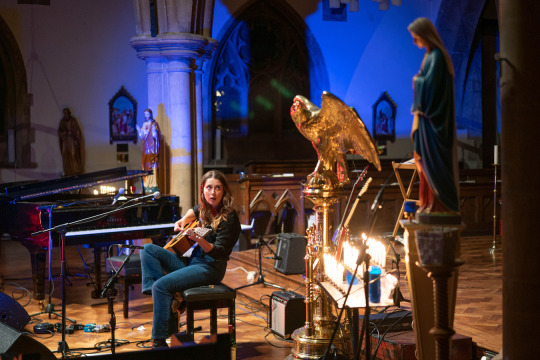
This is her first performance in London and she ‘s finding it “romantic” to be wearing a coat and scarf in the streets. Cummings’ hails from the title of 2019’s Flightless Records album, Refuge Cove. Her lyrics reveal a profound sense of place and feeling for nature. ‘Sweet Matilda’, a Mexican Summer series single, was written during Victoria’s wildfires and laments the destruction of the old Oz. She describes launching a kite over the charred landscape and its odyssey being joined by an eagle, which made her as “excited as a Jack Russell” and inspired the song ‘Fly a Kite’.
Cummings is also a stage actress. Her witty and charismatic banter forms a large chunk of the set. She is skilful at building intimacy and connection with her audience. She talks of Melbourne’s seemingly interminable lockdown where she felt starved of attention, and so, penned herself a love song. ‘Freak’, like ‘Fly a Kite’, appears on a second album, 2022’s Storm Queen. This was recorded and entirely self-produced during the extended period of social austerity. “It’s an important job being a freak,” she said to HollerCountry.com in January. The album is spare and simple, with bursts of ornamentation, and addresses themes of God, loss, alienation, hurt and healing. So it seems fitting she performs solo on acoustic guitar, switching to piano just once, for ‘Dreams’; an exquisite melody that, sadly, perishes too early.

Her voice has the deep, melodic richness of Tracey Chapman or Odette and a searing rasp at points of crescendo and intense feeling that invokes the ghost of Janis Joplin. Live there is an element of possession that takes hold of her, making her wild eyed and baring ursine teeth. St Matthias church was bomb damaged during the Second World War and might feel as though it’s been struck again. She talks of Van Gogh’s therapist in a painting in the Musee d’Orsay, whose expression implores Van Gogh to “stop”. “ My own ceiling screams back at me,” she confides. She often gazes up, mid song, at the nave’s beautifully restored roof. Birds feature heavily in her imagery and, on Storm Queen’s ‘Up In Flames’, she seems owl-like in her gaze, transmuting the transepts into a falconer’s mews.
To summit a stirring evening, Storm Queen’s ‘Heaven’ segues into Neil Young’s ‘Pocahontas’ and final offering ‘Paisley’, about the bleak, Scottish town, cements her in the anglosphere, with its caledonian tones. “See you on the other side,” she says. A thunder of applause foreshadows a groundswell for her fearless clouds to buffer these shores once again.
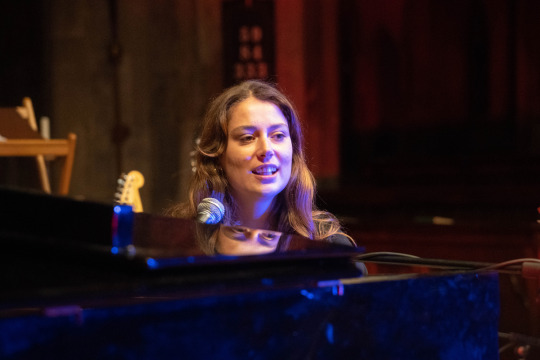
Words: Adrian Cross
Photos: Richard Gray
0 notes